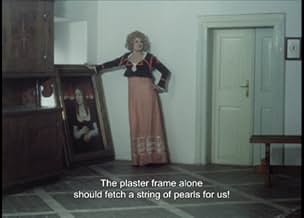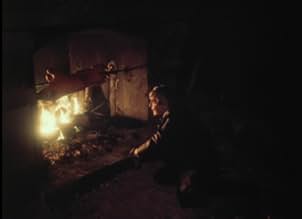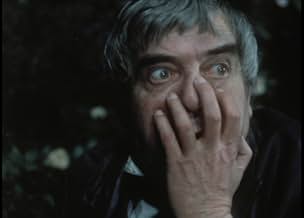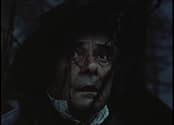AVALIAÇÃO DA IMDb
7,5/10
2,1 mil
SUA AVALIAÇÃO
Adicionar um enredo no seu idiomaIn this gothic rendition of the classic fairy tale, a merchant's youngest daughter is held prisoner by a mysterious winged beast.In this gothic rendition of the classic fairy tale, a merchant's youngest daughter is held prisoner by a mysterious winged beast.In this gothic rendition of the classic fairy tale, a merchant's youngest daughter is held prisoner by a mysterious winged beast.
- Direção
- Roteiristas
- Artistas
- Prêmios
- 2 vitórias e 1 indicação no total
Jorga Kotrbová
- Málinka
- (narração)
Tatjana Medvecká
- Julie
- (narração)
Avaliações em destaque
This film noir version of the classic fairytale, Beauty and the Beast, is captivating and magical. In many respects it is closer to the original story than other versions I have seen. I did see it once on television in the US. I have not been able to locate a copy of the video. I highly recommend it.
It's difficult to get past the opening scenes of close-ups of animal abuse, but at least that sets the tone for this very dark and murky adaption of the famous story. They say the acting life can be very glamorous - it certainly isn't the case here. No CGI safety-net, the performers attached to this story certainly seem to suffer for their art in a variety of uncomfortably cold situations.
It's good when horror films bring some new locations into their stories, but equally, it's always worth it to revisit the vast crumbling lairs of traditional settings, and that is done really effectively here; the story is given the most impressive horror treatment. Creatures hide in shadow - you only know they're there when you see a rolled eyeball or a moving, inhuman talon. There is enough of a fairytale quality to this to appeal to the inner child, and there are moments when the eyes will moisten! It's all accompanied by wonderful, sepulchral music, and directed like a hugely gothic TV film. My score is 8 out of 10.
It's good when horror films bring some new locations into their stories, but equally, it's always worth it to revisit the vast crumbling lairs of traditional settings, and that is done really effectively here; the story is given the most impressive horror treatment. Creatures hide in shadow - you only know they're there when you see a rolled eyeball or a moving, inhuman talon. There is enough of a fairytale quality to this to appeal to the inner child, and there are moments when the eyes will moisten! It's all accompanied by wonderful, sepulchral music, and directed like a hugely gothic TV film. My score is 8 out of 10.
The honest merchant Otec (Václav Voska) goes bankrupt when he loses the cargo of dowry for the wedding of his ambitious and envious older daughters Málinka (Zuzana Kocúriková) and Gábinka (Jana Brejchová) with decadent earls. His only chance to raise money is selling the painting of his former wife and mother of the sweet and pure youngest daughter Julie (Zdena Studenková). He travels through the Haunted Wood during the night, but his horse dies and he seeks shelter in the derelict castle of the Beast (Vlastimil Harapes). He is well received by his host that buys his painting by a fair price. When he is leaving the castle, he takes a rose for Julie from the Beast's rosebush and his host tells that he must pay with his life for the theft of the rose. He asks for permission to return home to give the jewels for his daughters, but he would return to the castle since he is a man of honor. The Beast accepts and tells that his life would be spared whether one of his daughters agrees to come to the castle. When Julie learns the proposal, she travels to the castle to save the life of her father. She is forbidden by the Beast to look at him, but along the lonely days, she falls in love with his voice and kindness.
"Panna a netvor" (1978), a.k.a. "Beauty and the Beast", is a dark version from Czechoslovakia of the classic fairy tale. The plot is flawed, since the curse and the magic of the beast are not explained, and ambiguous, since the conclusion is not sure that is the reality or the beautiful view of the ugliness of Julie. The performances, lighting and shadows are magnificent. My vote is seven.
Title (Brazil): "A Bela e a Fera" ("The Beauty and the Beast")
"Panna a netvor" (1978), a.k.a. "Beauty and the Beast", is a dark version from Czechoslovakia of the classic fairy tale. The plot is flawed, since the curse and the magic of the beast are not explained, and ambiguous, since the conclusion is not sure that is the reality or the beautiful view of the ugliness of Julie. The performances, lighting and shadows are magnificent. My vote is seven.
Title (Brazil): "A Bela e a Fera" ("The Beauty and the Beast")
9mar9
SBS-TV used to screen this film on an annual basis, but it has been missing in action for some years, which is cause for regret. The title may seem obscure, but a look at the alternative English translations ("Maiden and the Beast" and "Virgin and the Monster") should make this clearer. This is quite simply a wonderful interpretation of the classic fairy tale of Beauty and the Beast, produced and filmed in the then Czechoslovakia. Cinematic gems can be found in what may be thought to be unlikely places, and this film is an example.
Students of cinema may be aware that Cocteau did a version of this story in B&W, and there is of course the more recent and rather tame Disney version. This film is a very different proposition. For a start, it is unsuitable for young children because of some fairly graphic violence, including scenes of animal cruelty. The film-makers seem to strive for realism, particularly the scenes in the village where Beauty (here called Julie) lives, all mud and images of earthy rural life before the Industrial Revolution. But even the magical bits are portrayed realistically. The Beast's castle is maintained by an array of goblin-like servants, who skulk in the shadows of the fireplaces and chandeliers. If I have one complaint about this film, it is that the scenes are sometimes so dark that it is difficult to see what's happening. This does heighten tension, but it can be overdone.
The actors are great, especially the two charismatic leads. The Beast (Vlastimil Harapes) is fashioned more as a great bird of prey than Cocteau's leonine creation, and there is great suspense as he struggles with his inner violent nature (a sinister whispering voice) that is urging him to remain in his beastly form and kill the innocent Julie. Julie (Zdena Studenková) in turn is wonderfully portrayed. We can see why she is so obviously her father's favourite.
Fairy tales are expositions of the human condition, and the Beauty and the Beast story is no different. "Every woman has the power the make the one she loves beautiful". It's a simple theme, but this film explores it beautifully. See it if you can.
Students of cinema may be aware that Cocteau did a version of this story in B&W, and there is of course the more recent and rather tame Disney version. This film is a very different proposition. For a start, it is unsuitable for young children because of some fairly graphic violence, including scenes of animal cruelty. The film-makers seem to strive for realism, particularly the scenes in the village where Beauty (here called Julie) lives, all mud and images of earthy rural life before the Industrial Revolution. But even the magical bits are portrayed realistically. The Beast's castle is maintained by an array of goblin-like servants, who skulk in the shadows of the fireplaces and chandeliers. If I have one complaint about this film, it is that the scenes are sometimes so dark that it is difficult to see what's happening. This does heighten tension, but it can be overdone.
The actors are great, especially the two charismatic leads. The Beast (Vlastimil Harapes) is fashioned more as a great bird of prey than Cocteau's leonine creation, and there is great suspense as he struggles with his inner violent nature (a sinister whispering voice) that is urging him to remain in his beastly form and kill the innocent Julie. Julie (Zdena Studenková) in turn is wonderfully portrayed. We can see why she is so obviously her father's favourite.
Fairy tales are expositions of the human condition, and the Beauty and the Beast story is no different. "Every woman has the power the make the one she loves beautiful". It's a simple theme, but this film explores it beautifully. See it if you can.
What a wonderful film it is. Never having seen it before and only the Cocteau, made in 1946, a couple of times. I know there are many other versions but I think these two will be good enough for me when I like to watch this story again. I didn't really think that this one would be very good but it is amazing. Right from the beginning there is a stunning opening with a forest and a terrible ride with many horses and wagons, in the rain and the mud. Then there are the credits, even more wonderful as surrealist like paintings almost animated, unusual and original. Then back to the forest, the peasants have taken the wrong turning and they are lost but there is fire and horror. In the village and the man and his three girls with two of them getting married but he gets word that the wagons and their treasures and spices are lost and he will not make his money. There will be no wedding. He goes into the forest with his painting of his dead wife all seems to be okay and later with the third daughter she has to go into that gothic ruin in the forest and maybe find a husband. We know the story well enough but with this one and the beast or monster or her lover it is really well done and thrilling and beautiful to watch it all the time throughout. Breathtaking.
Você sabia?
- CuriosidadesThe beast looks like a bird in this version.
- Erros de gravaçãoWhen the father is travelling with the painting, a crow flies out from behind a log. A crew member's hands can be seen throwing the bird upward.
- ConexõesFeatured in Predcasná úmrtí: Bozský skeptik (2001)
Principais escolhas
Faça login para avaliar e ver a lista de recomendações personalizadas
- How long is Beauty and the Beast?Fornecido pela Alexa
Detalhes
Contribua para esta página
Sugerir uma alteração ou adicionar conteúdo ausente

Principal brecha
By what name was A Bela e a Fera (1978) officially released in India in English?
Responda































